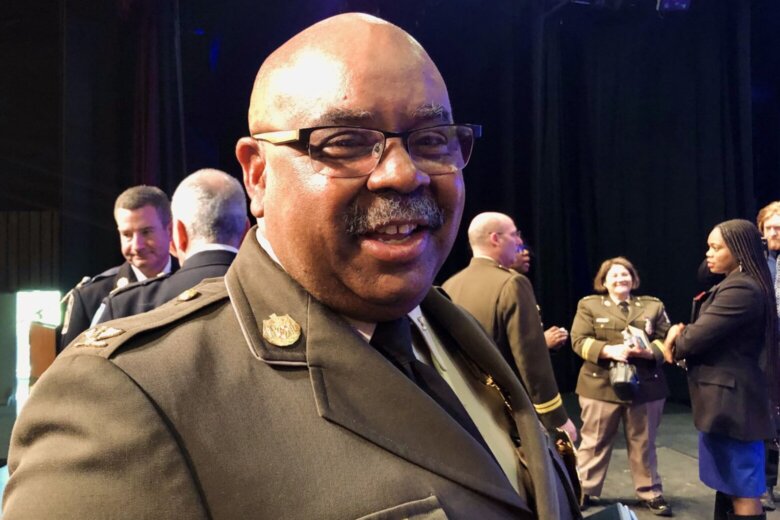
The police department in Montgomery County, Maryland, has lost 194 officers over the past five years and now has a sworn vacancy rate of 14%.
An analysis shows recent recruit classes have averaged 23 recruits each, “which remains too low to address current attrition,” according to the memorandum submitted to a county council committee Monday.
One of the biggest drivers in the drop in numbers, according to Montgomery County legislative analyst Susan Farag, is “there were a whole bunch of police officers hired in the ’90s because crime was really high.” But now those officers are at the age of retirement.
However, the figures cited in Farag’s analysis also show a combination of factors, including a spike in resignations in 2022 when 89 officers resigned and 55 retired.
In the previous year, 33 officers resigned and 55 retired. Farag told council members that recent legislation changed part of the collective bargaining agreement with the Fraternal Order of Police.
It would allow people to retire with a slightly richer benefit at 34 years, rather than 36, effective in 2025. Farag said that might account for a recent slowing of attrition, as people wait to get the enhanced benefit, but that it raises concerns about a potential spike in retirements in 2025.
Police Chief Marcus Jones reminded the panel during the Public Safety Commission session that he’s been sounding the alarm on staffing for some time. Jones, who is retiring effective July 1 after nearly 40 years in law enforcement, said he is intent on ensuring that efforts to increase staffing continue.
Another concern cited in the memo was a boost in overtime.
“There is a growing body of research that demonstrates associations between overtime and high uses of force, more community complaints and increased implicit bias,” Farag said, while emphasizing the research does not necessarily make a causal link, simply an association.
“We are monitoring our officers who are doing a lot of overtime,” Jones said. “That’s a concern for us for officer wellness.” He added that he is not seeing complaints going up “as a result of our officers utilizing more overtime.”
The memo also showed an increase in response times — priority calls increased from just over 5 minutes in 2019 to just over 6 minutes in 2023; while for routine calls, a similar increase was seen from a response time of 12 minutes and 21 seconds to 13 minutes and 18 seconds.
Assistant Police Chief Darren Francke told the panel response times can be variable due to the geography and the rates of calls for service across the county.
“When you get up from Rockville City, when you go up toward the north, it’s much more rural, and it takes longer to traverse those roads when we have a call,” Francke said.
Recruitment efforts have been increasing, with Farag saying recruit classes have been small but stable to an average of 23 in each of the past five classes.
A number of initiatives have been launched to address the issue, including providing signing bonuses of $20,000 to compete with those offered by neighboring jurisdictions. There has been an effort to increase the enrollment capacity of the cadet program, and discussion of changes to eligibility requirements for potential recruit candidates — such as whether to relax the standards that bar the use of marijuana for three years before applying to become a sworn police officer.
Call takers also needed
While Montgomery County’s police department works to fill vacant patrol officer positions, the people who pick up the phone when 911 is called are also in short supply.
“Of the 150 authorized positions, 64 are vacant,” Farag said.
That includes call takers and dispatchers who work at the county’s Emergency Communications Center.
Farag said the department has adapted to the staffing limitations by combining call channels. But she added that comes at a cost. “The short-staffing also impacts aspects of operations including training and quality control and supervision.”
Despite the staff shortage, Farag said data shows the average time to answer calls this year is 9 seconds. That’s down from last year.
“For calendar year 2023, the average was 10 seconds,” she said, noting the National Emergency Number Association standard is within 15 seconds.
Farag said the department is hiring, “but not at the rates they need.”
“On the bright side,” Francke said, legislation in 2023 that offers call takers and dispatchers the option to qualify for pensions has slowed the attrition rate.
“Additionally, what we have found is between the bonus that was also approved and that pension, our numbers of applications are going up.”
He said so far there are nine telecommunicators “ready to begin training.”
He said that’s double the previous year’s number.
Francke said there are additional initiatives to recruit ECC staff, including efforts at high schools, Montgomery College and the Universities at Shady Grove.
Get breaking news and daily headlines delivered to your email inbox by signing up here.
© 2024 WTOP. All Rights Reserved. This website is not intended for users located within the European Economic Area.









